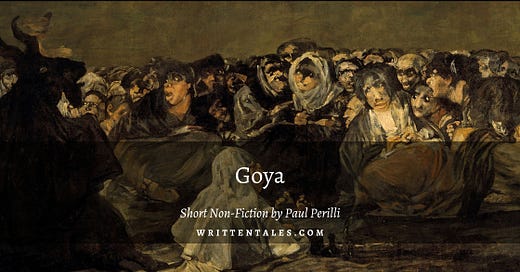If you enjoy this feature and would like to see more, let me know with a comment, 💌 share, ♥️ like, or better yet, a 🔄 restack!
You can purchase Written Tales Magazine in print or digital, or become a paid subscriber and download your favorite editions. To view our upcoming stories & poems, please visit our publishing schedule calendar.
He looked like the Spanish freedom fighter illuminated by a lantern in Goya’s 1808 painting “The Third of May.” His name was Chris. Like the freedom fighter, Chris had black bushy hair, long sideburns, thick eyebrows, and a mustache.
The painting, now in the Prado Museum’s collection, was reproduced in the European History textbook assigned to us during our junior year in college. The illuminated man has his arms flung out in defiance; a gesture directed at the French firing squad about to riddle him with bullets. By the time Goya painted it, the freedom fighters were seen as patriotic and heroic symbols. Aware of that, Chris reveled in his newfound fame. It wasn’t long before we called him Goya.
“Hey Goya, what you up to?” we said.
“Goya, how you been?”
In response, he threw out his arms. “Go ahead, shoot. I dare you.”
Commissioned by Spain’s provisional government after the ouster of the French and restoration of King Ferdinand VII, “The Third of May” portrays the civilian resistance to Napoleon’s armies during the French occupation of Madrid. Known as the “Dos de Mayo Uprising,” the rebellion that rose up was repressed by French forces that Goya memorialized in a companion work. “The Second of May” depicts a cavalry charge against the rebels in the Puerta del Sol public square, the site of several hours of fierce combat. Hundreds of Spaniards were rounded up and, as “The Third of May” illustrates, were executed in locations around Madrid. Civilian opposition persisted, and the five-year Peninsular War ensued. The first to be called a guerrilla war, Spanish forces were aided by the Portuguese and British armies until the French were defeated.
On a recent trip to the Prado, I saw “The Third of May” in person for the first time. Staring at it, an image of Chris back in our college days popped into my head. As did his unannounced visit to Boston on a summer break. In the door late on a Friday night, I found him sitting at the kitchen table with my mother and father, a plate of food and a bottle of soda in front of him. While Goya’s freedom fighter was frozen forever, I was aware Chris no longer looked anything like that. A Google search of his name and presumed Long Island, New York location yielded no identifiable results in the first six or so pages. I didn’t dig any deeper. I was content to keep his whereabouts, family life, professional accomplishments, and other details a mystery. Though I’ll assume he never had to face a firing squad and thus continues to be among us.
Paul Perilli's recent fiction has been featured in Fairlight Books, The Write Launch, The Fictional Café, The Writing Disorder, Unlikely Stories, and more. His recent nonfiction work appears in Otoliths, The Blotter, and O&L, with a forthcoming piece in Bridge Eight Press. Additionally, his novelette “The Luckier I Get” will soon be published in Aethlon.




